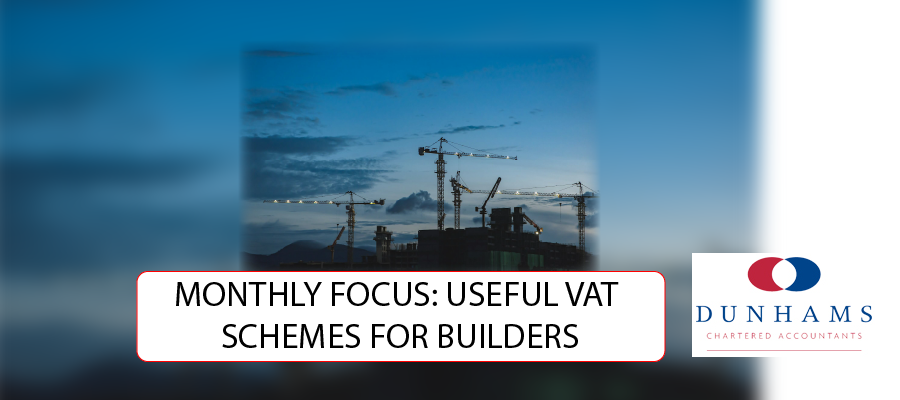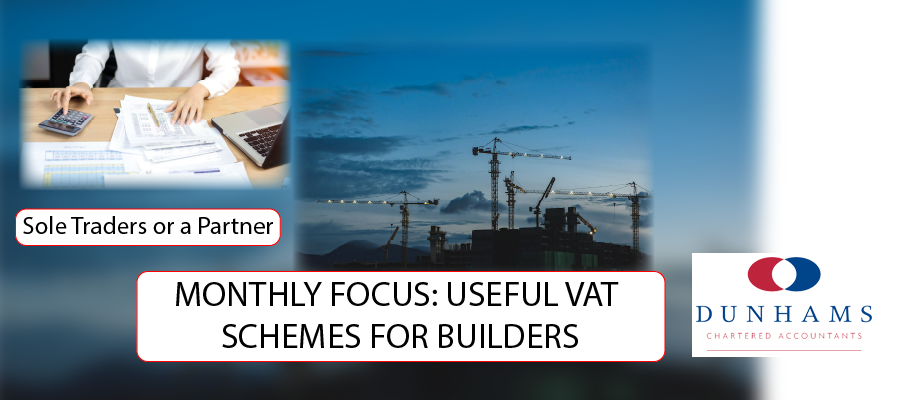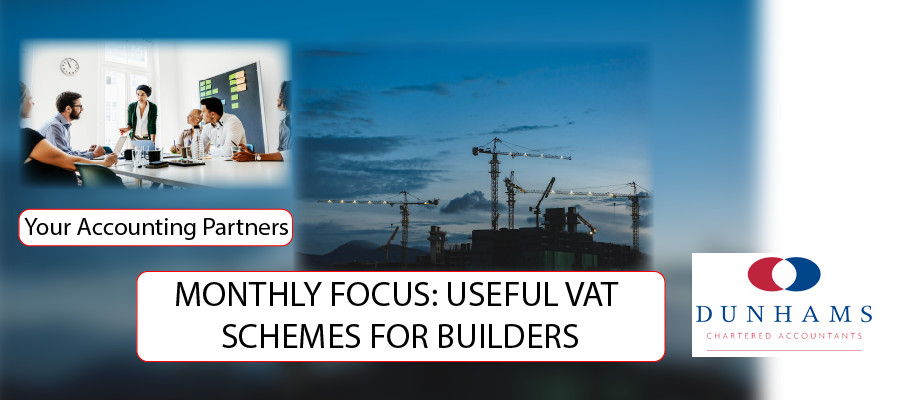
MONTHLY FOCUS: USEFUL VAT SCHEMES FOR BUILDERS
Posted on: 25-07-2024
Small Builders find VAT Help.
Accounting Partners get the right guidance on VAT Scheme’s.
MONTHLY FOCUS: USEFUL VAT SCHEMES FOR BUILDERS
VAT reporting can be an administrative headache, especially for smaller businesses. However, there are a number of schemes that can help to simplify things. In this Monthly Focus, we look at these in the context of businesses in the construction industry.

When should I consider special schemes?
Should you consider the flat rate scheme (FRS) if their annual sales are less than £150,000 excluding VAT? Are the potential cash flow savings of the cash accounting scheme (CAS) always worthwhile? And what about the annual accounting scheme (AAS), where a business submits one VAT return each year instead of four or twelve but must make monthly payments on account based on the previous year’s annual VAT payment?
To join either the cash accounting scheme or annual accounting scheme, expected taxable sales in the next twelve months must be less than £1.35m excluding VAT, i.e. it is based on a forward-looking test. The same situation applies with the flat rate scheme, i.e. the £150,000 threshold is based on expected sales in the next twelve months.
Example
Bob the Builder had annual sales of £200,000 excluding VAT in the year to 31 March 2024. However, because of his wish to do less work in the future, he anticipates sales will be £120,000 for the year ending 31 March 2025. Bob can join the flat rate scheme because £120,000 is less than £150,000.
Note. If Bob’s projected sales figure proves to be wrong, and the actual sales to 31 March 2025 exceed £150,000, then HMRC will not seek to withdraw him retrospectively from the FRS if he had a genuine expectation and logical basis of calculation for his turnover projection back in 2024.
FLAT RATE SCHEME (FRS)
What are the main rules with the FRS?
The main principles are as follows:
- the FRS is only available to a small business where annual taxable sales in the next twelve months are expected to be less than £150,000 excluding VAT. Historic sales are irrelevant
- you will charge VAT on their sales invoices in the normal way, i.e. 0%, 5% or 20% depending on the job in question
- you will apply a flat rate percentage to their VAT-inclusive sales for a period, depending on their relevant flat rate category. This is the VAT that is owed to HMRC on a return. However, the rate is applied to both zero-rated and reduced rate sales (as well as exempt income), which means that VAT is paid on some sales where no output tax or very little output tax has been charged to some customers
- FRS users do not claim input tax unless the spending relates to capital goods that cost more than £2,000 including VAT, e.g. a new van.
If you only do zero-rated work, or mainly zero-rated work, the FRS should be avoided. It should also be avoided since 1 March 2021 if your business makes supplies where the reverse charge rules will apply, i.e. no VAT will be collected from other VAT-registered builders because they will account for output tax on their own VAT returns instead.
Buy-to-let rental income is subject to FRS tax if it is earned by the same legal entity as your VAT-registered business. For example, a sole trader builder with VAT-exclusive sales of £100,000 from building work (all standard-rated) plus rental income of £500 per month from a buy-to-let flat in their own name will apply the flat rate percentage to £126,000 each year, i.e. £120,000 gross sales from building work plus £6,000 of annual rental income.
Should I focus on the scheme’s tax savings or time savings?
There used to be some very good tax savings with certain scheme categories but HMRC largely closed the door from 1 April 2017 with the introduction of a 16.5% rate for “limited cost traders”. This category is relevant to a business that is mainly supplying labour only services and does not buy many goods, as is the case with many builders. Until this date, many businesses, including a lot of builders, were able to make a big windfall with VAT by adopting favourable rates of 12% or less.
HMRC only promotes the time savings of the scheme, claiming that it is intended to be tax neutral, i.e. some businesses will pay less tax and others will pay more. But the reality is that most businesses will not join the scheme if it results in a higher tax bill. The main time savings with record keeping are as follows:
- there is no need to keep an input tax/purchase records – at least for VAT purposes
- tax payable can be calculated by applying the relevant FRS percentage to gross sales made during the period, i.e. no sales day book is needed with a separate VAT column
- no scale charge payments are needed for private use of car fuel.
If your business uses the cash-based turnover method to calculate their VAT payment, and all of sales are banked rather than paid in cash, the VAT payable each period will be very easy to calculate from business bank statements, i.e. bank account credits multiplied by the relevant flat rate percentage. This assumes, of course, that the only bank credits relate to building work and not capital introduced or private income etc.
What are the relevant FRS rates for builders?
This is where the FRS can become complicated because there are three different rates that could apply to your builder clients and the rate could be different each time a VAT return is completed! Therefore, it’s often a good idea for builders to avoid using the scheme and adopt normal VAT accounting instead. This advice is even more relevant if the builder has a range of work that attracts different rates of VAT, i.e. some zero-rated or reduced rated sales.
Labour only building or construction services – 14.5%
General building or construction services – 9.5%
Limited cost trader – 16.5% – if “relevant goods” are purchased costing less than 2% of gross turnover or more than 2% of turnover but less than £250 in a VAT quarter.
The rules concerning what are classed as “relevant goods” with the limited cost trader category are complicated. Certain items are excluded, e.g. road fuel, food or drink for staff, capital expenditure goods. See VAT Notice 733, para 4.6 (available here) for a list of goods that are included and excluded from this definition.
The choice between the first two categories is helpfully clarified by the legislation: reg 55K of the VAT Regulations 1995:
“Labour-only building or construction services means building or construction services where the value of materials supplied is less than 10 per cent of relevant turnover from such services; any other building or construction services are ‘general building or construction services’.”
Example
For the VAT period ended 31 March 2024 electrician Emma has £24,000 of gross sales, split between labour £14,000, materials £6,000 and VAT of £4,000. The material sales clearly exceed 10% of gross sales (relevant turnover), so she can apply the lower FRS rate of 9.5% for this period.
Is it best to avoid the scheme if my business uses a lot of VAT-registered subcontractors?
Yes, this will almost certainly be the case. A business that uses a lot of VAT-registered subcontractors will be sacrificing more input tax by using the FRS than another builder who uses subcontractors that are not VAT registered, or in-house labour employed on a PAYE basis.
Example
Keith the kitchen fitter subcontracts work to local fitters who are all registered for VAT. Keith’s annual sales figure is £100,000 excluding VAT (labour only) and his main expenses with VAT are subcontractor payments of £40,000 plus VAT each year. The subcontractor payments are only for labour.
With normal VAT accounting, Keith will pay VAT of £12,000 each year, i.e. output tax of £20,000 less input tax of £8,000. But with the FRS, he will pay tax of £17,400, i.e. £120,000 gross sales multiplied by the labour only builder rate of 14.5%. And if he did not buy relevant goods exceeding £1,000 in the year, the payment with the FRS would be £19,800, i.e. gross sales multiplied by the limited cost trader percentage of 16.5%.
When must my business leave the scheme?
The good news is that the leaving threshold is higher than the joining figure. You should check their gross sales once a year, on the anniversary date of when you first joined the scheme. If this figure exceeds £230,000 including VAT, then you must leave the scheme at the end of the VAT period that includes the anniversary date. Sales of capital assets are excluded from the calculations.
You will not need to leave the scheme if you write to HMRC and persuade the officer that total VAT-inclusive sales in the next twelve months will be less than £191,500.
Example
Bricklayer Betty joined the FRS on 1 January 2010 and completes VAT returns on a calendar quarter basis. For the twelve-month period to 1 January 2025, her gross sales were £240,000 including VAT. As this figure exceeds £230,000, she must leave the scheme on 31 March 2025, i.e. the end of the VAT period that includes the anniversary date of when she joined the scheme.
If you would like any assistance with any of these points.
CASH ACCOUNTING SCHEME
Should builders always use always use the cash accounting scheme if they are eligible?

The main advantage of the CAS is that output tax is not included on a VAT return until a customer pays their dues. This is usually a later date than the normal time when output tax is paid to HMRC, i.e. based on the sales invoice date. However, the main disadvantage of the scheme is that your business cannot claim input tax until you have paid suppliers. This means that a builder will probably not benefit from using the scheme in the following situations:
Sales. There are a lot of zero-rated or reduced-rated sales, so the output tax advantage is less important than the opportunity to claim input tax according to the purchase invoice rather than payment date.
Cash flow. If you are paid very promptly by customers, but tend to pay suppliers very slowly, the output tax gains are not worthwhile, but the input tax delay might be more significant.
There is no need to notify HMRC that your business wants to join the scheme. This also applies to leaving it as well.
Example
Double glazing fitter Dave only works on new dwellings for house builders, his sales are zero-rated for VAT purposes. He buys his glass from a merchant who give him 90 days credit. He also gets good payment terms on a wide range of other supplies that include VAT. The CAS is totally unsuitable for Dave; his cash flow will be adversely affected because of the delay he will encounter claiming input tax on his expenses.

What are the other advantages of the CAS?
An important benefit is that scheme users get automatic bad debt relief on their sales. In other words, there is no need to claim bad debt relief because output tax is only declared on a return when payment has been made.
The other advantage is that VAT returns can be completed by using a cash book system and if all payments and receipts go through the business bank account, which is properly reconciled at the end of each period, this means that returns are likely to be correct.
All boxes on a VAT return are based on payments dates, i.e. including the outputs and inputs figures in Boxes 6 and 7.
When must my business leave the scheme?
As with the flat rate scheme, the exit threshold for the CAS is greater than the entry level. However, the exit threshold needs to be considered at the end of each VAT period, checking the total taxable sales made in the previous twelve months. If total taxable sales have exceeded £1.6m excluding VAT in this twelve-month period, your business will need to leave the scheme. This means that output tax must be included on all debtor sales on this return, but input tax can be claimed on unpaid purchase invoices.
To ease the cash-flow challenge of suddenly having to account for output tax on closing debtors, your business can account for output tax on the next two returns when they are paid. But the same outcome applies to claiming input tax on creditors. When the six-month transition window has expired, output tax must be declared on all outstanding debtors but there is now scope to claim bad debt relief on these sales if they are more than six months overdue for payment.
Can my business use the cash accounting and flat rate schemes at the same time?
The answer is no, but FRS users can adopt the cash-based turnover method. This method gives the same output tax benefit as the CAS, i.e. VAT is only included on a VAT return when payment has been received from a customer.
If you would like any assistance with any of these points.
ANNUAL ACCOUNTING SCHEME
What are the benefits of the annual accounting scheme for builders?
The AAS means that one VAT return is submitted each year, with payments on account being made during the year, based on the previous year’s annual VAT liability. Most advisors tend to discourage builders from using the scheme for the following reasons:
Payments on account could be too high
Think of a builder who had a high VAT payment on their last annual return because they did all standard-rated work and had a good trading year. But this year, they are doing quite a lot of zero-rated jobs, and turnover has reduced as a result of the difficult economic climate. The high payments on account could cause a big cash-flow challenge for the business.
Payments on account could be too low
The opposite situation could occur, e.g. the annual VAT return last year produced a low VAT payment because of zero-rated jobs but there are mostly standard-rated jobs in the current trading year. The low payments on account will produce a large VAT payment when the annual return is submitted, and the balancing payment is owed.
Record keeping
The discipline of having to keep up-to-date accounting records in order to complete monthly or quarterly VAT returns might be lost if an annual VAT return is submitted instead. A builder trying to complete records on a retrospective basis is more likely to make errors with the VAT calculations.
If you identify that payments on account are too low or too high during the year, they can be adjusted by contacting HMRC’s unit in Grimsby.
What are the potential advantages of the AAS?
The AAS should not be completely written off – it might be a good scheme for some builders:
- if your business employs a bookkeeper to submit each VAT return, there could be a saving of fees if only one return is submitted each year
- if your business has a bad history of putting in late returns and paying tax late, and has incurred default surcharges etc, the reduced number of returns and discipline of monthly electronic payments on account might be very worthwhile.
The cash-flow benefits of low payments on accounts might provide important working capital to enable a growing business to expand. But the directors or business owners will need to ensure that money is available to pay the high balancing payment that will be payable after the end of the year.
Example
Roofer Ron used the annual accounting scheme and paid £40,000 VAT for the previous year. He paid £4,000 in nine instalments in the current year, i.e. based on 10% of the previous year’s liability. However, Ron’s business has enjoyed significant trading growth and his actual VAT liability this year is £80,000. Ron will have a large balancing payment to pay of £44,000 when he submits his annual return, i.e. £80,000 less £36,000 paid on account. The priority for you as his advisor is to make sure that he can pay this balance, i.e. the VAT money has not been spent on other projects.
When must a business leave the scheme?
The exit threshold is the same as the cash accounting scheme, i.e. annual taxable sales have exceeded £1.6m excluding VAT. This figure is usually based on the annual VAT return submitted.HMRC must be told of important changes to business circumstances as they arise. This would include reporting a big increase in turnover during the annual accounting year, rather than waiting until the end of the year. You should therefore check sales on a regular basis.
If you would like any assistance with any of these points.
